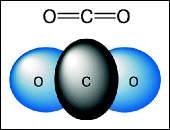, Maneli Mozaffarieh1 and Hans Bebie2
(1)
Department of Ophthalmology, University of Basel, Basel, Switzerland
(2)
Institute for Theoretical Physics, University of Bern, Bern, Switzerland
Abstract
Carbon dioxide is a molecule composed of two oxygen atoms covalently bonded to a single carbon atom (Fig. 11.1). It is colorless and exists in gaseous form at room temperature. In nature, carbon dioxide is used by plants during photosynthesis to make sugar, for example, and it is liberated by all organisms that depend on oxidative phosphorylation. Burning in a fire or “burning” in mitochondria also leads to carbon dioxide formation through a set of redox reactions summarized as “cellular respiration.”
11.1 What Is Carbon Dioxide?
Carbon dioxide is a molecule composed of two oxygen atoms covalently bonded to a single carbon atom (Fig. 11.1). It is colorless and exists in gaseous form at room temperature. In nature, carbon dioxide is used by plants during photosynthesis to make sugar, for example, and it is liberated by all organisms that depend on oxidative phosphorylation. Burning in a fire or “burning” in mitochondria also leads to carbon dioxide formation through a set of redox reactions summarized as “cellular respiration.”


Fig. 11.1
Carbon dioxide (CO2), produced by combustion reactions. It is a symmetrical molecule with a slight polarity, which makes it more soluble than molecular oxygen. At room temperature, unlike water, carbon dioxide is a gas
11.2 Transport of Carbon Dioxide
As a waste product of cellular metabolism, carbon dioxide needs to be constantly transported away from the cells and, ultimately, from the body. Although carbon dioxide has a greater solubility than oxygen in water, only 5 % is transported in unchanged form (physically dissolved in water). About 10 % of carbon dioxide is bound to reduced hemoglobin and the vast majority is transported as bicarbonate ions (HCO3−) (Fig. 11.2).
 < div class='tao-gold-member'>
< div class='tao-gold-member'>





Only gold members can continue reading. Log In or Register to continue
Stay updated, free articles. Join our Telegram channel

Full access? Get Clinical Tree


